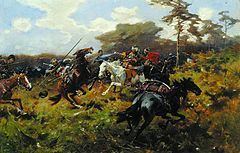8,000-10,000 3,500-7,000 Start date November 23, 1619 | 650-2,500 850-3,000 | |
 | ||
Similar Thirty Years' War, War of the Polish Succession, Battle of Lomnice, Battle of Wolgast, Siege of Pilsen | ||
Battle of humenn 1 w war 1914 1915
The Battle of Humenné (Hungarian: Homonnai csata, Polish: bitwa pod Humiennem or pierwsza odsiecz wiedeńska) took place on November 22–23, 1619 near Humenné (eastern Slovakia) during the first period of the Thirty Years' War between the Transylvanian army and the joined loyalist Hungarian and Polish forces of Lisowczycy. It was the only battle of that war to involve the Polish-Lithuanian Commonwealth.
Contents
The battle was won by the Polish cavalry led by Walenty Rogawski against the Transylvanian corps commanded by George Rákóczi, the future Prince of Transylvania.
Battle of humenn 1 w w 1914 1915
Prelude
A lot of nations of the Holy Roman Empire saw the Thirty Years' War as a perfect opportunity to (re)gain their independencies. One of them was Hungary led by Gábor Bethlen, Prince of Transylvania. He joined Bohemia in the anti-Habsburg Protestant Union. In a short period of time, he conquered northern Hungary and Bratislava, and in November he started a siege of Vienna - the capital city of Austria and the Holy Roman Empire. The situation of Emperor Ferdinand II was dramatic. The emperor sent a letter to Sigismund III of Poland, and asked him to cut the supply lines of Bethlen from Transylvania. He also sent George Drugeth, count of Homonna - former rival of Bethlen, now Lord Chief Justice of Royal Hungary - to Poland, to hire forces for the Habsburgs.
The Polish-Lithuanian Commonwealth did not want to participate in the war, so it remained neutral. But the king being a strong sympathizer of the Catholic League and the Habsburgs, decided to help the emperor. Though, he didn't want to send forces directly, he allowed Drugeth to hire mercenaries in Poland. Drugeth hired around 8,000 Lisowczycy led by Rogawski, who joined his own 3,000 men. The joined army included aroud 11,000 soldiers, but this number is disputed.
Battle
The Lisowczycy faced George Rákóczi's corps near Humenné in the Carpathian Mountains in the evening on november 22. Walenty Rogawski did not manage to hold the cavalry together and it split up. Next day, on november 23, Rákóczi decided to send his infantry in order to pillage the enemy's camp. While it was doing so, Rogawski finally gathered his troops and unexpectedly attacked the Transylvanians. In a short time, Rákóczi had to announce a retreat. The battle was won by the Polish.
Aftermath
When Bethlen found out about Rákóczi's defeat, he had to break the siege, gather his soldiers and return to Bratislava, and sent a cavalry of 12,000 to northern Hungary led by George Széchy, in order to secure it against the Lisowczycy. Ferdinand II made him sign a cease-fire and on January 16, 1620 they signed a peace treaty in Pozsony (now Bratislava).
The battle of Humenné was an important part of the war as the Polish intervention saved Vienna - the capital city of the Holy Roman Empire - from Transylvania. That is why some Polish sources call it the first Vienna relief - the second being the famous Battle of Vienna in 1683.
